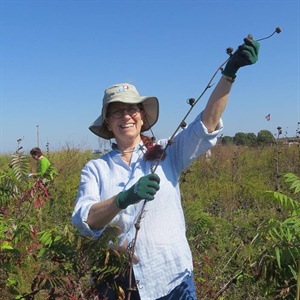Throughout the last month, you may have heard about, or participated in, our Prairie Seed Collection Days. In cooperation with Audubon Arkansas and with the assistance of volunteers, we have collected seeds from native plants in Downs Prairie Natural Area, Railroad Prairie Natural Area, and other areas, to be used in habitat restoration projects in the Grand Prairie region. These efforts mark the beginning of the Arkansas Native Seed Program, a program the Arkansas Natural Heritage Commission staff have been hoping to establish for many years.
Planting native seed is often part of a habitat restoration or improvement plan. However, local native plant seed sources are limited. Out-of-state sources are relied upon, and although these seeds may be the right species, they will not have the same genetic make-up as local populations. Local plants have unique adaptations to specific soils and climate conditions, giving them the best chance of survival. They are the plants that naturally occur within a particular ecosystem, which benefits wildlife. And importantly to us, they preserve an area’s natural heritage.
The Arkansas Native Seed Program reflects the ideals of the National Seed Strategy for Rehabilitation and Restoration. This national initiative, launched in August 2015 by the Bureau of Land Management, encourages preservation of native seed as a “critical national resource asset” for future generations. It began with the need for restoration after national disasters such as wildfires and hurricanes caused extensive damage to large areas of land. In such cases, reseeding with native plants is imperative to deter non-native invasive seeds from flourishing and displacing natives. The motto of the National Seed Strategy is “The right seed, in the right place, at the right time”. The initiative is not legislation, but it provides an organized, multi-partner plan to have ample supplies of genetically appropriate native seed available when needed.
Several states now have native seed programs. In June 2016, ANHC hosted the first Arkansas Native Seed Program meeting with partners from federal, state, and local agencies, and non-profit and private organizations. These partners now include the U.S. Fish and Wildlife Service, Arkansas Game and Fish Commission, Arkansas Highway and Transportation Department, Audubon Arkansas, The Nature Conservancy, Ozark Ecological Restoration, Inc., and the Illinois River Watershed Partnership. Working together, the group has established a plan to provide appropriate seed for projects across Arkansas. Seed that is currently being collected will be stored and planted next spring by individual farmers in single-species, agricultural-style plots. In that way, enough seed can be produced to meet the needs of agencies, organizations, and individuals for restoration purposes. The seeds of individual species can be mixed to meet the needs of a particular site and project. Future potential benefits are new market opportunities for private growers, improved and expanded wildlife habitat, new partnerships, and research opportunities.
To succeed, all of these programs require long-term coordinated efforts. Time and research will be needed to determine the most important species to propagate, as well as the best techniques and management practices for collecting, storing, growing, and distributing native seeds. Public education and support is vital. Visit http://www.blm.gov/ut/st/en/prog/more/CPNPP/0/seedstrategy.html to learn more about the National Seed Strategy.
